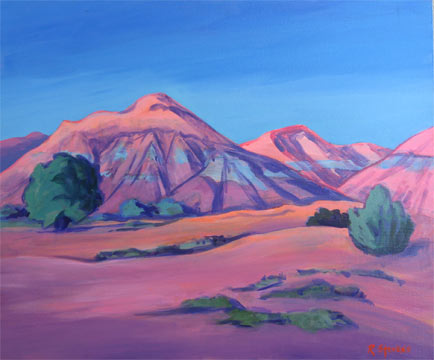
Lurking behind this exhibition of works by Robert G. Stevens (1926-2004) that date from 1990 until his death is a narrative of a life-long commitment to painting, a familiar story that echoes those of so many artists of his generation. Born in the Bay Area, he served in the South Pacific in World War II and later, in the Korean War. Upon his return to the States, he attended the California College of Arts and Crafts where he studied under George Post. Like Post, and so many other artists, he assumed he could not make a living from his art and so in 1950, he became a scientific illustrator for the Lawrence Livermore Laboratories. Stevens sold his urban landscape watercolors at the weekend sidewalk fairs, specifically the one at Sather Gate at UC Berkeley. He worked at the Lab from 9 to 5, five days a week and would come home to paint in the evenings and on Saturdays, creating about two paintings a week for thirty years. “Cable Car, Powell & Mason” (watercolor, 1971) and “Sausalito” (watercolor, 1983) reveal an application of Post’s idea that the work should emerge from an initial reaction to the image and be “accented with the artist’s own particular calligraphy.” Stevens’ evolution of an economy of line and color and his focus on a verisimilitude that tends toward abstraction through his use of blocks of color become given elements for the later works that make up this show.
In 1983, after thirty years at Lawrence Livermore, he was informed that he had to switch to computer illustration. Instead, Stevens quit his job. The next year, he moved to New Mexico to dedicate himself to painting full-time, and also because he wanted to experiment with brighter colors and light. Initially he continued to work in watercolors. He began experimenting with oils, but abandoned that because he couldn’t stand the smell. He decided that acrylic was more suited to the dry and color-splashed landscapes of the Southwest.
A controlled palette dominates these works, as does the line and volume that Stevens creates with color. In “Garden of the Gods” shadows heighten the ochre bluff that dominates the space. An interplay between the dark green of the trees that form a line across the space contrasts with the reddish bluff, and is heightened by the brownish and greenish strokes of grass that lie in the foreground. The light that cuts over the edge of the bluff draws the eye upward toward the range of mountains that lie beyond. The sense of isolation is interrupted by the abandoned fence aligned on the left with the bluff.
“Turquoise Hills,” a curvilinear composition of ochre, brown and purplish tones is contrasted by the dark green trees that balance the composition on either side. A turquoise band cuts through the middle of the composition, through the hills themselves, aligning them with the transparent clear blue sky. Below, the monumentality of the landscape is underscored by a small house or building that is barely visible in the tiny valley at the foot of the hills. The subject of “Entrance to Echo Amphitheatre” is a hiker on the path below the mountains. Glorious ripples of ochre-brownish curves cut through with reds, purples and blues to contrast the landscape’s monumentality as against the small scale of the figure. Through Stevens’ eye these mountains overpower humanity. In “Walpi at Night,” a watercolor, purple, blue and lavender curvilinear lines flow diagonally from right to left and move upward forming the base of the enormous structure in the center of the space. The man-made ruin and the earth flow out of the same palette against a reddish night sky broken only by a plume of smoke that rises out of the ancient site. Located in northern Arizona and founded in the 10th century, Walpi is a Hopi settlement that, as the smoke attests, is still inhabited today.
Two other works shift our gaze to Pasadena. In “The Quiet Bridge” we view a landscape of the Japanese bridge at the Huntington Gardens, branches of cherry blossoms floating across the left of the canvas, the rhythm of the water made more evident by the koi swimming across our view. “Green Hotel Rendez-Vous” invites us to dwell on the tryst that awaits the man seated at the door.
Viewing Stevens’ work inspires us to reflect on the passion for painting and on the energy and dedication that this work manifests. Stevens’ work speaks for so many artists who painted or created for the hell of it, with an unbending intent, by a need to paint and make art, without thoughts or hopes of a market, of recognition, or participation in the public or academic art discourse. In his case at least, we have a link to his story and a final decade of work. Maybe early works will surface somewhere out there, in a garage sale or flea market and we can begin to recover the full history of this artist.
Published courtesy of ArtSceneCal ©2011
